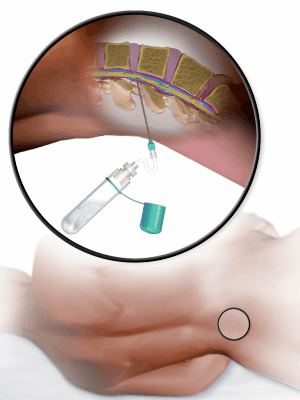Lumbar Puncture Headache: Science In Clear Language
Whether you’re suffering from a lumbar puncture headache, or you just want to avoid one, this article will help you find the solution. First, let’s take a brief look at why these headaches happen in the first place.
Cerebrospinal fluid (CSP) is a clear liquid that surrounds the brain and spinal cord. It acts in part as a cushion of protection. The body keeps your CSP at a certain pressure.
When this pressure is too high or too low, headaches may warn you of the problem. A number of things might cause the pressure to change, but we won’t get into all of those here.

Your doctor may also perform a lumbar puncture in order to inject medicine.
The lumbar puncture itself shouldn’t lead to a significant headache. The problem comes when there is leakage of the CSP after the procedure, leading to an unexpected drop in pressure. The headache that often results is known as a post-dural puncture headache (and in the past has also been called a post-lumbar puncture headache or just lumbar puncture headache).
Incidentally, even an epidural anesthesia can lead to this type of headache. It shouldn’t, but at times the membrane containing the CSP is punctured unintentionally.
Risks, and Avoiding the Lumbar Puncture Headache
The headache is more common in women between 31 and 50 years (older sources indicate a higher risk for young adults – check your sources for more information), and the risk increases if they’ve had the post-dural puncture headache in the past. A small body mass also increases your risk.
The best thing to do to lower your risk is to see a doctor who has experience doing the procedure. Details such as the way the procedure is done and the type of needle used may affect the outcome. Feel free to ask your doctor about these things.
When the Headache Comes
To be diagnosed with a post-dural puncture headache, your headache symptoms must begin within 5 days of the procedure.
One clue to the source of this headache may be that it gets worse when you sit or stand, but gets better when you lie down. This is only a clue – but it isn’t always the case. If that is your experience, it will help your doctor to rule out other possible causes.
It is possible that a headache will start more than 5 days after the lumbar puncture, but you may not get the same diagnosis in that case. There are several related headache types that are very similar.
These headaches may last for a few days, or continue for weeks.
Symptoms often include a stiff neck and even some trouble hearing.
Treatment
For some immediate relief, try lying on your back. If the case isn’t too severe, your doctor may recommend over the counter medication to help with the pain. Most of these headaches should go away without the need of any further treatment.
If you’ve had three days of pain and it’s still going strong, your doctor will probably recommend further treatment. However, do tell your doctor right away if you have a new headache – depending on your situation, some treatments are recommended to be done within the first 24 hours.
A clever procedure known as an epidural blood patch is quite common. A small amount of your blood will be injected to seal the leak with a a blood clot. The pressure should soon be restored, and your headache symptoms will go away.
There are several other treatments that may be tried, whether to quickly seal the leak or to diminish the lumbar puncture headache pain while the problem resolves on its own. If the normal treatments do not work, surgery may be required.
Final notes
Again, the lumbar puncture headache (officially known as a post-dural puncture headache) is only one of the headaches caused by low CSP pressure. The timing of the headaches and the studies your doctor may call for may vary, but the overall idea is similar.
If you’re prone to these headaches, it may be something you need to plan for for the few days after your procedure. However, if possible you should talk to your doctor before the procedure is done about the risks, and see your doctor right away if any headache symptoms develop. If you live with a headache like this for too long, it could end up being a very serious or even fatal condition.
But for most people who are under a doctor’s care, the condition is temporary and will not require any risky treatments.
References and more information:
- The International Classification of Headache Disorders, 3rd edition (beta version)
- Post lumbar puncture headache: diagnosis and management (National Center for Biotechnology Information)
- Cerebrospinal fluid (CSF) (Encyclopædia Britannica)
- Spinal headaches (Mayo Clinic)
- Lumbar puncture (spinal tap) (Mayo Clinic)
- Post-dural puncture headache: part I diagnosis, epidemiology, etiology, and pathophysiology.
- Spinal analgesia and auditory functions: a comparison of two sizes of Quincke needle.
